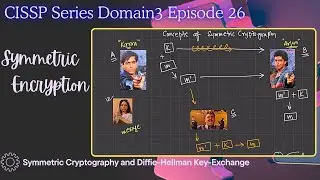CISSP Series Domain3 Episode 25 - Introducing Cryptography
Navigating the Depths of Cryptography: A CISSP Recap
Hey there, friends! Welcome back to another episode of "Concepts of CISSP." Today, I'm excited to dive into a recap of our last discussion, focusing on the intriguing realm of cryptography. So grab a seat, and let's embark on this journey together.
In our previous video, we explored the fundamentals of cryptology, the art and science of encryption and decryption. Cryptology branches into two main categories: cryptography and cryptanalysis. Cryptography involves the systematic process of transforming plain text messages into encrypted ones using a key, while cryptanalysis seeks to decipher encrypted messages without access to the key.
Picture this: you start with a plain text message, apply a key to encrypt it, and voila! You have your encrypted message, also known as ciphertext. To decrypt it, you simply reverse the process using the same key. It's a dance between encryption and decryption, a fundamental concept in cryptography.
Now, let's talk techniques. Cryptography offers two primary methods for transforming plain text into ciphertext: substitution and transposition. Substitution involves replacing characters, while transposition entails rearranging them using various mathematical operations. When you combine these techniques, you get a product cipher, adding layers of complexity to your encryption.
But wait, there's more! Ever heard of Caesar Cipher, Playfair Cipher, or Rail Fence Technique? These are just a few examples of substitution and transposition techniques, each with its unique approach to encryption.
Now, onto the heart of encryption: the key. In cryptography, the key is everything. It determines the type of encryption used, be it symmetric or asymmetric. Symmetric encryption relies on a single key for both encryption and decryption, while asymmetric encryption utilizes two keys for the same purpose.
Key length plays a crucial role in encryption strength. A longer key means greater complexity and enhanced security, making decryption a formidable challenge for would-be attackers. Remember, the key is the gatekeeper to your encrypted messages.
In symmetric key cryptography, we delve into algorithm types and modes. Algorithm type dictates the size of the plain text encrypted in each step, while algorithm mode determines how encryption steps are executed. Stream ciphers encrypt bit by bit, relying solely on substitution, whereas block ciphers encrypt blocks of bits, incorporating both substitution and transposition.
Now, let's not forget about key exchange. When sharing keys between parties, ensuring their security is paramount. After all, a compromised key jeopardizes the integrity of your encrypted communications.
So, what's next? In our upcoming video, we'll unravel the intricacies of symmetric and asymmetric key encryption, shedding light on key exchange mechanisms and security measures.
If you found this journey through cryptography enlightening, give it a thumbs up, share it with fellow CISSP aspirants, and don't forget to subscribe for more insights. Until next time, stay curious and stay secure. Thank you for tuning in!































